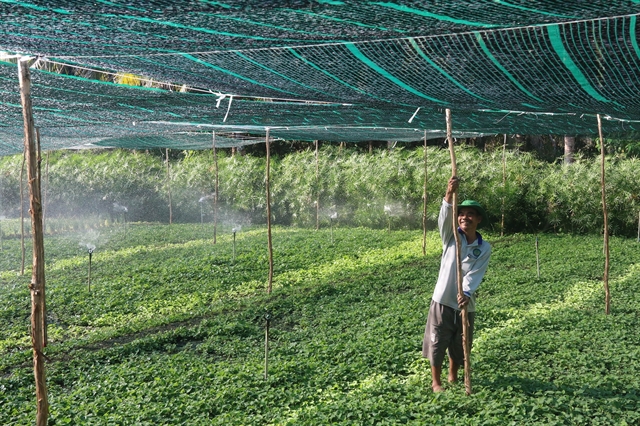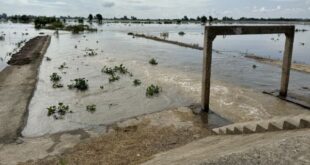
HÀ NỘI — Việt Nam increased its public expenditure for climate change in 2016-2020, however, more investment is needed to address climate risks and to mobilise more support from international and private sources, according to experts at a workshop held on Friday.
The Ministry of Planning and Investment and the United Nations Development Programme (UNDP) in Việt Nam launched a report on Climate Public Expenditure and Investment Review of Việt Nam at the workshop.
The report reviews the climate change budgets of six ministries and 28 provinces, as well as Cần Thơ City, between 2016-2020.
The majority of climate budgets from ministries and provinces in Việt Nam between 2016 and 2020 was for climate change adaptation, however, it was not sufficient enough to address the climate risks that the country face, according to the report.
Nguyễn Thị Bích Ngọc, Deputy Minister of the Ministry of Planning and Investment, said: “The budget preparation and planning to implement and realise strategies, programmes and goals in response to climate change are extremely important.”
“The results of this report will be very useful in enhancing the climate change responsiveness of the public financial management system, promoting the transition from input-based budgets to output-based budgets, and creating more favourable conditions for climate-related interventions by ministries and provinces.
“This contributes to the successful implementation of Việt Nam’s international commitments to climate change response, as well as identifying the needs for investment in climate change, improving efficiency, and establishing a basis for mobilisation and diversification of domestic and international resources for climate change,” she said.
UNDP Resident Representative in Việt Nam Caitlin Wiesen said: “Việt Nam has increasingly allocated its financial resources for climate change response in 2016-2020.”
The total budget and expenditure of the six ministries, 28 provinces and Cần Thơ City was almost US$6.5 billion, or an average of $1.3 billion per year during 2016-2020, according to the report.
The report shows that adaptation is the dominant expenditure of the climate change budget, representing over 70 per cent of the ministries’ climate change budget and over 90 per cent of the provinces.
“This is consistent with policy priorities for public investment, whereas mitigation expenditure is mainly in the private sector.”
“However greater efforts and support are required to scale up investment in adaption, especially from international sources and the private sector,” said Wiesen.
At the provincial level, the average climate budget of the 28 provinces and 1 centrally managed city also increased steadily by about 53 per cent, from about $700 million in 2016 to almost $1.1 billion in 2020.
The climate change budget represented a relatively stable proportion of the total provincial budget, varying between 16-21 per cent of the total budget. While the domestic budget allocation was stable, ODA tended to increase. The provinces’ climate expenditure was focused on concrete interventions, such as food and water security, response actions to sea level rise and forest development.
Wiesen said: “Climate change, green growth strategies and their action plans should be reflected in the objectives and targets of policies and plans of sectors and provinces, as well as the overall Socio-Economic Development Plan.”
She also stressed the need to systematically integrate climate budget coding and tracking into the planning and budgeting process.
“This will enable consistent, systematic and transparent tracking and reporting of the financial and technical delivery of climate change commitments as required by the enhanced transparency framework in reporting to UNFCCC,” she added.
As well as international and national experts in environmental and finance sectors, the workshop was also attended by representatives from the Ministry of Planning and Investment, Ministry of Agriculture and Rural Development, Ministries of Industry and Trade, Science and Technology, Natural Resources and Environment, Transport, Construction, provincial government representatives, Cần Thơ City representatives, development partners and international organisations and university representatives.
At the launch of the report, the participants also discussed the challenges and opportunities to mobilise new financial resources, solutions for effective budget allocation and expenditure, monitor the results of budget allocation and improve investment efficiency for climate change response.
The CPEIR provides a review of climate change expenditures and budgets of six ministries including the Ministry of Agriculture and Rural Development, Ministry of Natural Resources and Environment, Ministry of Transport, Ministry of Industry and Trade, Ministry of Construction, and Ministry of Science and Technology in the 28 provinces, and Cần Thơ City. It covers investment and recurrent expenditure with domestic resources and ODA for 2016-2020. — VnExpress News
- Reduce Hair Loss with PURA D’OR Gold Label Shampoo
- Castor Oil Has Made a “Huge” Difference With Hair and Brow Growth
- Excessive hair loss in men: Signs of illness that cannot be subjective
- Dịch Vụ SEO Website ở Los Angeles, CA: đưa trang web doanh nghiệp bạn lên top Google
- Nails Salon Sierra Madre
 VnExpress News The News Gateway of Vietnam
VnExpress News The News Gateway of Vietnam





